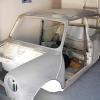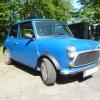
Static Timing
#1

Posted 02 October 2012 - 10:56 AM
Hi all, starting to put the ignition system in on my project and hopefully get it running soon.
I’ve got a little stuck tho, because the distributor has been off the engine it out of sync, I’ve done a bit of googleing and found I need to set something called the static timing.
Firstly I need to tell you there’s points and condenser in the dizzy that I want to change to electronic, does this make a difference to the procedure? Should I set the timing with the points in or go straight for electronic ignition? I can’t guarantee the points are set right tho.
I’ve read the Haynes book and this is as far as I’ve got on how to do it
Move cylinder no.1 (drivers side? to TDC (top dead centre) take the rocker cover and TDC is just before the valves start to move.
Then look at the timing marks between the crank pulley and the block, each point is 4 degrees, I’ve read somewhere that you need to turn the engine round until the mark on the crank pulley lines up at 6 degrees? Is that right?
Go back to the dizzy, it’s at this stage now in the cycle that cylinder no.1 needs to be firing, so logic states that the rotor arm needs to pointing to plug lead no.1 so rotate the dizzy round until it is then lock it in place.
Is that it? Seems quite straight forward but I’ve read about people using lights, not strobe lights for setting the dynamic timing, but a light that switches on when the dizzy’s in the right place or something, what’s all that about?
And what the inspection panel above the fly wheel, it says I need to remove that and check something, what am I checking for? Or does it not apply to me?
Any help is always gratefully received, if someone wants to cut and paste and edit what I’ve written above then maybe we could get this put into the FAQ or something.
Trac
#2

Posted 02 October 2012 - 11:00 AM
#3

Posted 02 October 2012 - 11:03 AM
Trac
Edited by tractor, 02 October 2012 - 11:04 AM.
#4

Posted 02 October 2012 - 11:55 AM
Static timing is accurate enough until you start worrying about emissions testing.
See this link for my PDF on static timing: http://home.mindspri...taticTiming.pdf
You said you were thinking of going with electronic ignition. PLAN on re-setting the timing after you install the electronic ignition. Do not just make the change and assume the timing has not bee affected. Some electronic ignitions (such as the Ignitor modules) can be static timed, others cannot).
#5

Posted 02 October 2012 - 12:42 PM
Bob
#6

Posted 02 October 2012 - 01:50 PM
Cylinder number 1 is the one nearest the radiator.
Bob
Thanks bob
See this link for my PDF on static timing: http://home.mindspri...taticTiming.pdf
That document is awesome Doug, very precise but easy to understand thank you very much.
just one last thng to check then, do you set the static timing 6 degrees BTDC?
trac
#7

Posted 02 October 2012 - 02:34 PM
#8

Posted 02 October 2012 - 04:14 PM
#9

Posted 02 October 2012 - 07:13 PM
#10

Posted 02 October 2012 - 07:37 PM
seems this timing buisiness is bit of a black art then and is very subjective to the engine
i recon i should be able to get it going now then at least - pending oil pressure check -
when i do it'll be a huge landmark in the project,
Thanks again
Trac
P.S i had to google pinking, i've definatly heard of it but couldn't remember what it was
#11

Posted 02 October 2012 - 08:39 PM
Once the engine is running and at temperature, bring the engine to 4000 RPM using the idle speed screws.
Use your (advance type) timing light to set the ignition advance to 32 BTDC.
Lock the distributor down and return the engine to the desired idle speed.
Test drive your car. Place it under heavy load by accelerating hard, up hill, in too high a gear (try 4th on a hill you would normally go up in 3rd gear).
Listen for ANY bad noises (clatter, pinging, knocking). If you hear ANY noise, stop and retard the timing by about 2 degrees and repeat your test.
Stop when you no longer hear any bad noises.
Use your timing light to measure what the timing advance is at idle. Write down that advance figure AND the RPM where you measured the advance. You can use those figures later to time the engine at idle.
This will set the maximum advance your engine can handle for its unique condition, state of build, AND the grade of fuel you are using. If you make major engine component changes OR start buying cheaper gas, you may need to change the timing again.
#12

Posted 07 October 2012 - 02:57 PM
Hey me again, has anyone tried static timing with the accuspark ignition set, will it work? i bought myself this one.
http://www.ebay.co.u...d=180592574975
Doug you mention in your write up a few electronic modules can't be static timed does that include the one i have?
Trac
#13

Posted 07 October 2012 - 06:34 PM
#14

Posted 07 October 2012 - 06:55 PM
I'm new to this so learning all the time and i definatly won't forget that tip..!!
Trac
Edited by tractor, 07 October 2012 - 06:56 PM.
#15

Posted 02 February 2022 - 08:35 AM
Static timing is accurate enough until you start worrying about emissions testing.See this link for my PDF on static timing: http://home.mindspri...taticTiming.pdfYou said you were thinking of going with electronic ignition. PLAN on re-setting the timing after you install the electronic ignition. Do not just make the change and assume the timing has not bee affected. Some electronic ignitions (such as the Ignitor modules) can be static timed, others cannot).
2 user(s) are reading this topic
0 members, 1 guests, 0 anonymous users
-
Bing (1)


















